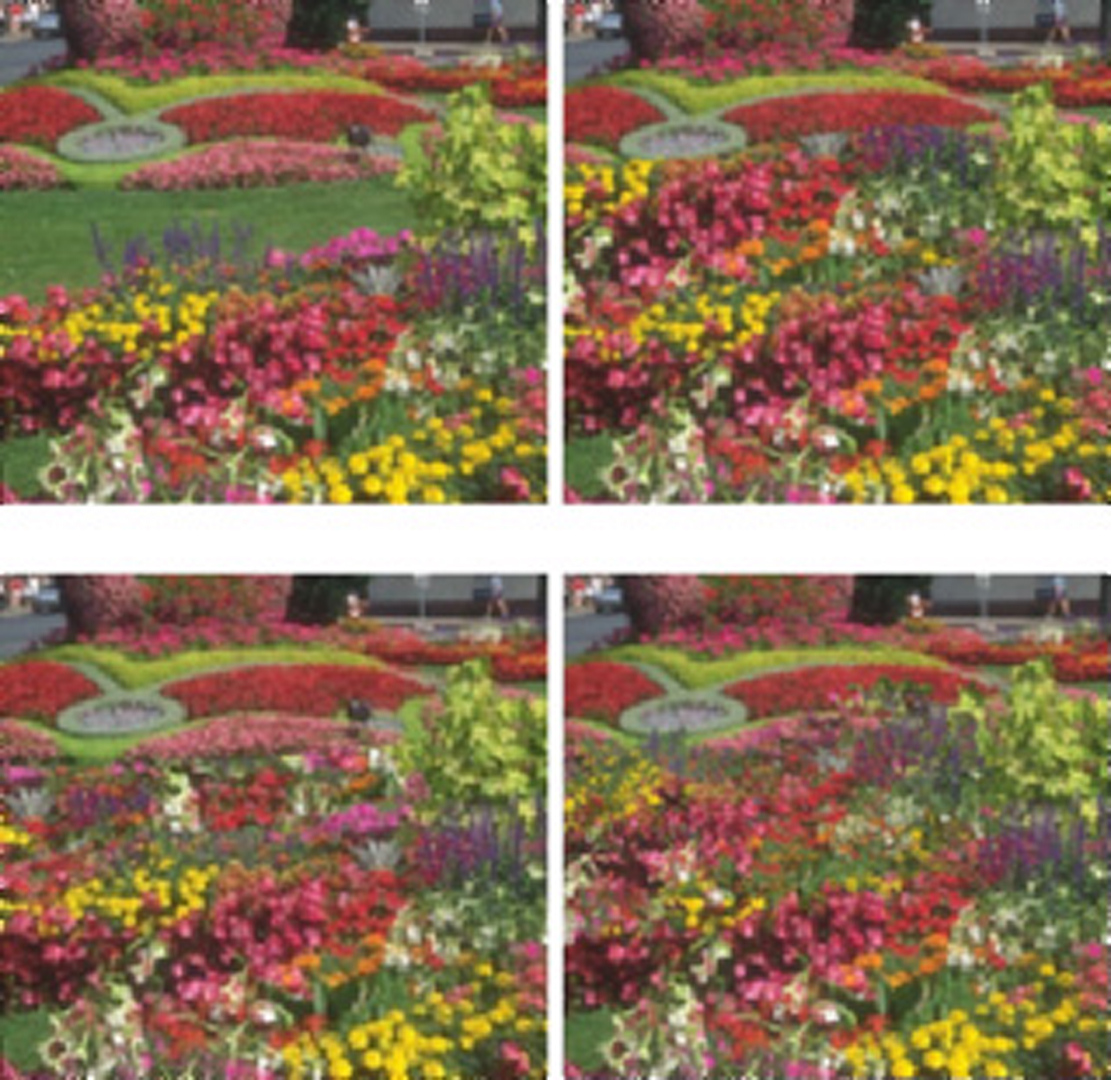“Object-based image editing” by Barrett and Cheney
Conference:
Type(s):
Title:
- Object-based image editing
Presenter(s)/Author(s):
Abstract:
We introduce Object-Based Image Editing (OBIE) for real-time animation and manipulation of static digital photographs. Individual image objects (such as an arm or nose, Figure 1) are selected, scaled, stretched, bent, warped or even deleted (with automatic hole filling) – at the object, rather than the pixel level – using simple gesture motions with a mouse. OBIE gives the user direct, local control over object shape, size, and placement while dramatically reducing the time required to perform image editing tasks.Object selection is performed by manually collecting (subobject) regions detected by a watershed algorithm. Objects are tessellated into a triangular mesh, allowing shape modification to be performed in real time using OpenGL’s texture mapping hardware.Through the use of anchor points, the user is able to interactively perform editing operations on a whole object, or just part(s) of an object – including moving, scaling, rotating, stretching, bending, and deleting. Indirect manipulation of object shape is also provided through the use of sliders and Bezier curves. Holes created by movement are filled in real-time based on surrounding texture.When objects stretch or scale, we provide a method for preserving texture granularity or scale. We also present a texture brush, which allows the user to “paint” texture into different parts of an image, using existing image texture(s).OBIE allows the user to perform interactive, high-level editing of image objects in a few seconds to a few ten’s of seconds
References:
1. ADOBE SYSTEMS INCORPORATED 2000. Adobe Photoshop Version 6.0 User Guide.Google Scholar
2. BEIER, T. AND NEELY, S. 1992. Feature Based Image Metamorphosis. In Computer Graphics (Proceedings of ACM SIGGRAPH 92), 26(2), ACM, 35-42. Google Scholar
3. BERN, M. AND EPPSTEIN, D. 1992. Polynomial-size nonobtuse triangulation of polygons. International Journal of Computational Geometry and Applications 2(3), 241-255.Google Scholar
4. BOOKSTEIN, F. L. 1989. Principal Warps: thin-plate splines and the decomposition of deformations. In IEEE Transactions on PAMI, 11(6), 567-585. Google Scholar
5. EFROS, A. A. AND LEUNG, T. K. 1999. Texture Synthesis by Non-parametric Sampling. In IEEE International Conference on Computer Vision (ICCV 99), Corfu, Greece. Google Scholar
6. EFROS, A. A. AND FREEMAN, W. 2001. Image Quilting for Texture Synthesis and Transfer. In Proceedings of ACM SIGGRAPH 2001, ACM Press/ACM SIGGRAPH, New York. E. Fiume, Ed., Computer Graphics Proceedings, Annual Conference Series, ACM, 341-346. Google Scholar
7. ELDER, J. H. AND GOLDBERG, R. M. 1998. Image Editing in the Contour Domain. In Proceedings of IEEE Conference on Computer Vision and Pattern Recognition (CVPR 98), 374-281. Google Scholar
8. GAO, P. AND SEDERBERG, T. W. 1998. A work minimization approach to image morphing, The Visual Computer 14, 390-400.Google Scholar
9. THE GIMP. http://www.gimp.org.Google Scholar
10. HARRISON, P. 2001. A Non-hierarchical Procedure for Re-synthesis of Complex Textures. In Proceedings of Winter School of Computer Graphics 2001, 190-197.Google Scholar
11. HASBRO, INC. 2001. Mrs. Potato Head. http://www.hasbropreschool.com/Google Scholar
12. MCINERNEY, T. AND TERZOPOULOS, D. 2000. T-Snakes: Topology Adaptive Snakes. In Medical Image Analysis, Vol. 4, 73-91.Google Scholar
13. MORTENSEN, E. N., AND BARRETT, W. A. 2001. A Confidence Measure for Boundary Detection and Object Selection. In Proceedings of IEEE Conference on Computer Vision and Pattern Recognition (CVPR 2001), Vol. 1, 477-484.Google Scholar
14. MORTENSEN, E. N. AND BARRETT, W. A. 1995. Intelligent Scissors for Image Composition. In Proceedings of ACM SIGGRAPH 1995, ACM Press/ACM SIGGRAPH, Computer Graphics Proceedings, Annual Conference Series, ACM, 191-198. Google Scholar
15. MORTENSEN, E. N. AND BARRETT, W. A. 1998. Interactive Segmentation with Intelligent Scissors. In Graphical/Models and Image Processing, 60(5), 349-384. Google Scholar
16. MORTENSEN, E. N. AND BARRETT, W. A. 1999. Toboggan-Based Intelligent Scissors with a Four Parameter Edge Model. In Proceedings of IEEE Conference on Computer Vision and Pattern Recognition (CVPR 99), 452-458.Google Scholar
17. MORTENSEN, E. N., REESE, L. J., AND BARRETT, W. A. 2000. Intelligent Selection Tools. In Proceedings of IEEE Conference on Computer Vision and Pattern Recognition (CVPR 99), Vol. II, 776-777.Google Scholar
18. MOUNT, D. M., AND SAALFELD, A. 1988. Globally-equiangular Triangulations of Co-circular Point in O(n log n) Time. In Proceedings of the 4th Symposium on Comp. Geometry, ACM. Google Scholar
19. PRAUN, E., ET AL. 2000. Lapped Textures. In Proceedings of ACM SIGGRAPH 2000, ACM Press/ACM SIGGRAPH, Computer Graphics Proceedings, Annual Conference Series, ACM, 465-470. Google Scholar
20. REESE, L. J. 1999. Intelligent Paint: Region-Based Interactive Image Segmentation. Masters Thesis, Department of Computer Science, Brigham Young University, Provo, UT.Google Scholar
21. SANDER, P. V., ET AL. 2000. Silhouette Clipping. In Proceedings of ACM SIGGRAPH 2000, ACM Press/ACM SIGGRAPH, Computer Graphics Proceedings, Annual Conference Series, ACM, 327-334. Google Scholar
22. SCANSOFT, INC. 2001. Kai’s SuperGoo. http://www.scansoft.com/products/goo.Google Scholar
23. SHEWCHUK, J. R. 1996. Triangle: Engineering a 2D Quality Mesh Generator and Delaunay Triangulator. First Workshop on Applied Computational Geometry, ACM, 124-133. Google Scholar
24. SIBSON, R. 1978. Locally equiangular triangulations. Computer Journal, 21:243-245.Google Scholar
25. SMITH, M. D. 2002. Sally’s Flower. Graphics Lab, Brigham Young University. [email protected] Received by personal communication.Google Scholar
26. VINCENT, L. AND SOILLE, P. 1991. Watersheds in Digital Spaces: An Efficient Algorithm Based on Immersion Simulations. In IEEE Transactions on Pattern Analysis and Machine Intelligence, 13(6):583-598. Google Scholar
27. WEI, L. AND LEVOY, M. 2000. Fast Texture Synthesis using Tree-structured Vector Quantization. In Proceedings of ACM SIGGRAPH 2000, ACM Press/ACM SIGGRAPH, Computer Graphics Proceedings, Annual Conference Series, ACM, 479-488. Google Scholar
28. WOLBERG, G. 1998. Image Morphing: a Survey, The Visual Computer 14, 360-372.Google Scholar
29. XU, Y., ET AL. 2000. Chaos Mosaic: Fast and Memory Efficient Texture Synthesis. Technical Report MSR-TR-2000-32, Microsoft Research.Google Scholar
30. YU, XIAOHUA, MORSE, B. S., AND SEDERBERG, T. W. 2001. Image Reconstruction Using Data-Dependent Triangulation. IEEE Computer Graphics and Applications Vol. 21, No. 3, 62-68. Google Scholar





